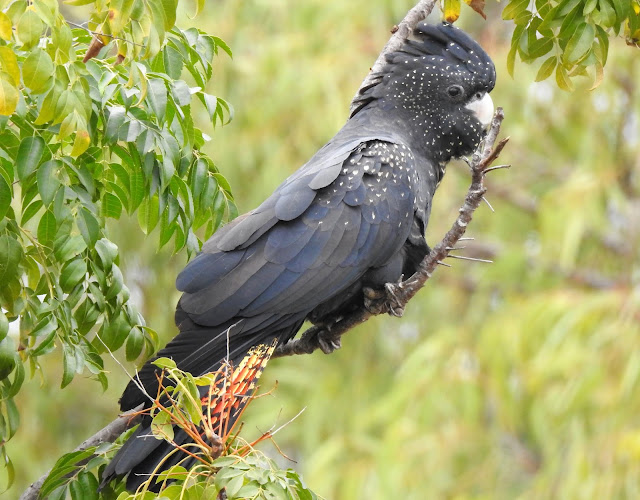GLOSSY BLACK COCKATOO
Australia has been described as the land of the parrots and with some 60 species of cockatoo, lorikeet, fig-parrots and parrots the description is warranted. Perhaps of all the Australian parrots the ones that command the most respect and awe are the Cockatoos and among them, the group of black cockatoos.
 |
| Female - top picture. Male - picture below |
Now this group has a number of species; two near identical species that exist in the south west of Western Australia, the wide ranging Red tailed Black Cockatoo, the Yellow tailed Black Cockatoo, the striking Palm Cockatoo and this week’s Bird of the Week, the glossy Black Cockatoo.
Now as a group these birds are simply awesome; they are not subtle and are loud and huge. Globally Macaws and south east Asian Hornbills are the only birds that come close to demanding a staring, dumbstruck response.
Glossy Blacks, which I will call them, have been chosen as they are able to be seen around my part of the planet, here on Queensland’s Sunshine Coast.
They are the smallest of the Black Cockatoos.
And the most specialised; as they appear to feed almost exclusively on the seeds of She-oaks -Allocasuarina species (A. verticillata, A. littoralis, A. torulosa). Cones are picked individually and fragmented in specialized bill to release seeds; these are then separated by working tongue and lower mandible against upper mandible and discarding the chaff. According to Birds of the World their cone-handling time is 40–140 seconds, depending on size of cone. One can walk around a She oak and see the discarded seed pods if the birds have been using it for feeding.
Confusingly, perhaps, they have red tails and thus invite confusion with the Red tailed Blacks but similarities between the two species are limited. The Red tails, pictured below, also overlap with the range of Glossies in part.
 |
| Red tailed Black Cockatoos [male upper; female lower] |
The species is no where particularly common and has been listed as Vulnerable. The isolated Kangaroo Island sub species is endangered, particularly so after bush fires ravaged their habitat in early 2020.
There has been work on the Sunshine Coast to create and expand habitat for this species with the planting of of Casuarina trees.
On our Brisbane Birding Breaks tour of the Sunshine Coast and Hinterland we will hope to find some of the few Glossy Black Cockatoos.
AUSTRALIAN BIRDING SAFARIS
Come birding with us.



No comments:
Post a Comment